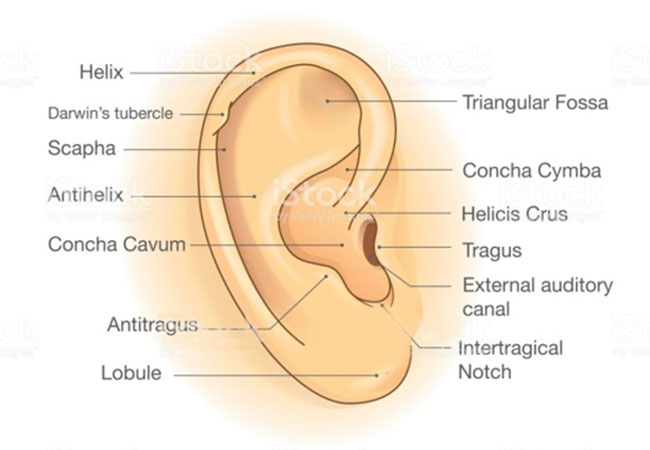
The ear is the organ of hearing and balance. There are three parts of ear: outer ear, middle ear and inner ear.
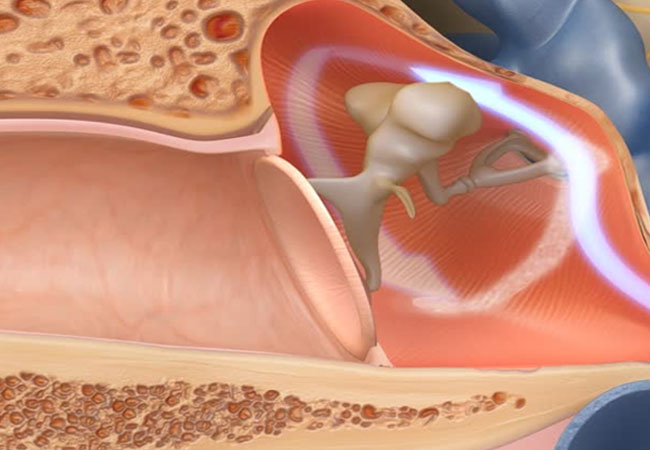
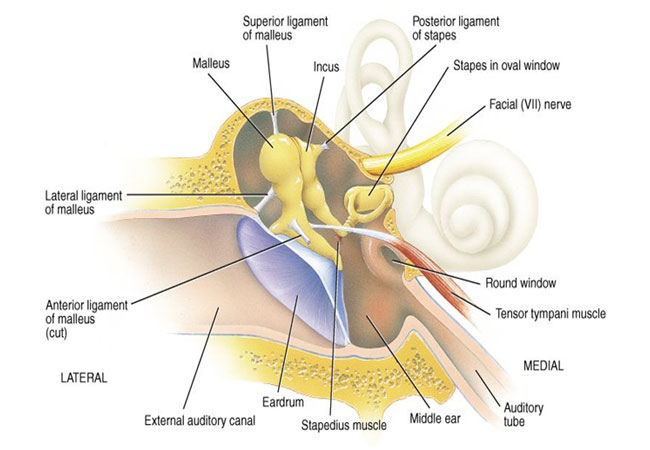
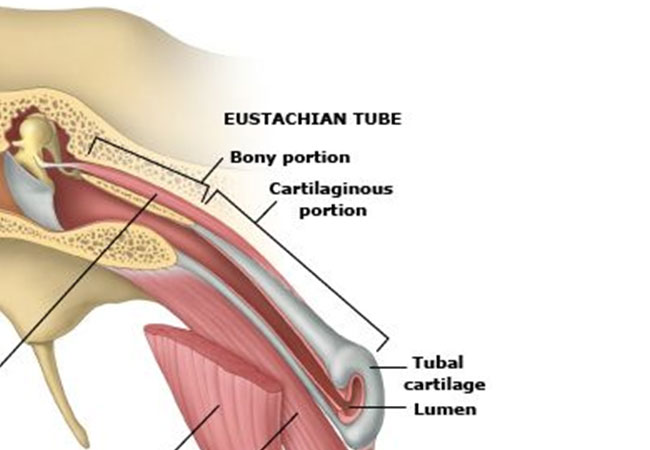
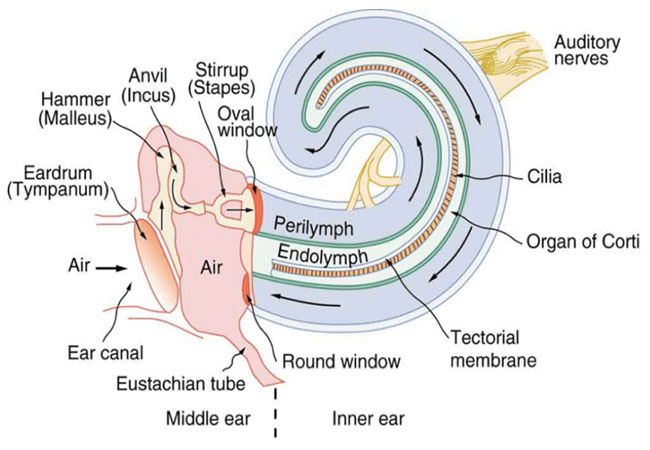
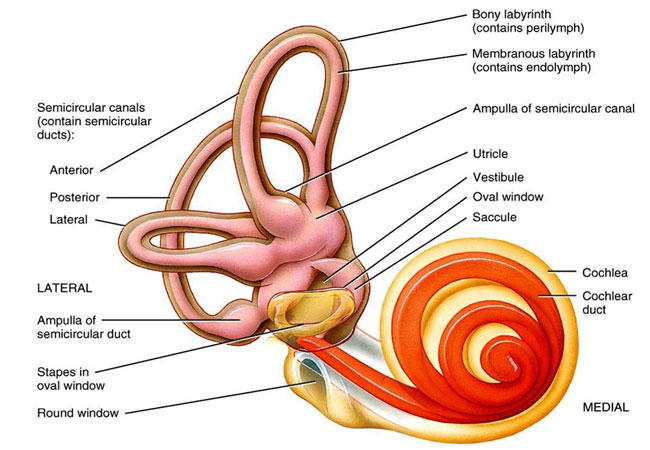

How our ear functions and how brain receives and perceives sound impulses hold the key to better understanding of hearing and hearing loss. The process of hearing starts with a properly functional outer ear that collects the sound waves emitted from a source and passes it through ear canal to the eardrum (Tympanic Membrane). The impact of sound waves on the eardrum creates vibration, which further results in movement of three bones located in the middle ear.
The movement of the bones, especially of stapes, which is also the smallest of the three, results in vibration of the oval window situated between middle and the inner ear. This vibration impacts the fluid in the inner ear which further transmits the signals to cochlea, the organ which is responsible for hearing.
The vibration of the fluid inside the inner ear bends the hair cells that act as receptors. The bending of these cells triggers impulses that are transmitted to the brain through auditory nerves. Brain on receiving the impulse translates into the sound and comprehends it for further processes.
Hearing loss is when your ability to hear is reduced. A hearing loss makes it more difficult for you to hear speech and other sounds. The most common causes of hearing loss are noise and ageing. In most cases a hearing loss cannot be cured. Hearing loss, or hearing impairment happens when there is a problem with one or more parts of the ear or ears, the nerves coming from the ears, or the part of the brain that controls hearing.
Hearing loss is different in every person. People also may use the words deaf, deafness, or hard of hearing when they're talking about hearing loss. Actually, in other words we can say Hearing loss is a loss of the loudness or clarity of sounds. Most people have had temporary hearing loss at least once in their lives.
Hearing tests should always be performed by an experienced audiologist (a professional specialized in hearing), who will test hearing in order to determine the type, cause and severity. These tests vary according to the patient’s age and needs. The results are then discussed with the patient and/or their family.
The degrees of hearing loss vary from a mild hearing loss (affecting one’s ability to hear soft sounds) to a moderate, severe or even profound hearing loss (where the individual cannot hear most sounds).
Hearing loss occurs to most people as they age. Hearing loss can be due to the aging process, exposure to loud noise, certain medications, infections, head or ear trauma, congenital (birth or prenatal) or hereditary factors, diseases, as well as a number of other causes. Hearing loss in adults, particularly in seniors, is common.
The problem of hearing loss, if not since birth, is often a like a process than an occurrence. Other than due to accidental reasons, when the loss can be instantaneous, normally it is caused over a prolonged period of time. In the beginning the hearing loss can be deceptive; however, with time, it goes profound and start interfering with your ability to react to a sound and thus becomes prominent during conversational speech.
Age related degeneration of middle ear, inner ear and nerves that are responsible for hearing are main cause of hearing loss.
Measles, mumps or any other such type of viral infection, along with diseases like Meniere's syndrome, tumours of the hearing nerve and meningitis are the second largest reason for hearing loss.
There are certain drugs that are known to hamper the functionality of hair cells present in the inner ear; causing hearing loss. Quinine, aminoglycosides, aspirin are some of such drugs that can trigger hearing loss.
Otitis media is a condition that causes formation of fluid in the middle ear. This fluid hampers hearing to a great extent and can be triggered due to sore throat and inflamed tonsils.
If the outer ear or the ear canal is malformed; then it causes acute hearing loss.
Excessive noise pollution or if exposed to loud noise for a long period of time, then such exposure can cause permanent hearing loss.
Drastic change in the air pressure over the eardrums in comparison to the air pressure maintained in the inner ear; such as during adventure sports like paragliding or scuba diving; there are chances of perforation of eardrums, resulting in hearing loss.
Ear canal, if is blocked due to Wax build-up, then it stops sound to travel towards the inner ear and thus can also cause hearing loss. However, such type of hearing loss can be easily treated with proper medical attention and personal hygiene.
The main cause of hearing loss is something we all have to come to terms with - our age. However, it can also be a result from disease,trauma or long-term exposure to damaging noise.
At the moment, some hearing losses can be treated by either drugs or surgery. Most people with hearing difficulties find that a hearing aid recommended by a Hearing Aid Audiologist will improve their hearing.

Copyright © 2020-2025 Arth Speech And Hearing Clinic All Rights Reserved.